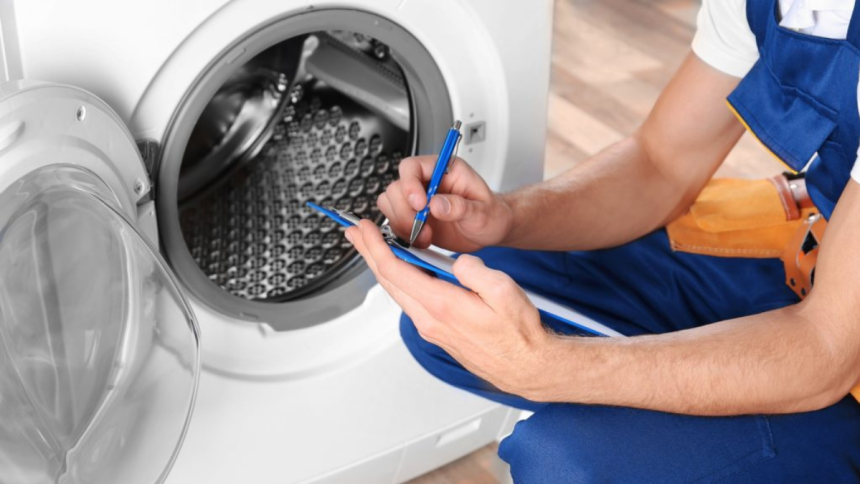I’ve lost count of how many times customers call me saying: “My dryer’s working, but my clothes are still wet when it stops”.
If that hits close to home, you’re not the only one. Dryers are easy to forget about until they stop working the way they’re supposed to. The good news? In many cases, fixing a dryer is simpler than you’d expect and often not as expensive as people fear.
What’s Going on Inside a Dryer
Let me start with the basics. I usually walk through with customers. A dryer isn’t just blowing heat at your clothes. It’s using a system. Warm air is generated (through electricity or gas), pulled into the drum, passed over your clothes as they tumble, and then pushed out through the vent to the outside.
If even one part of that process is off, if the air can’t flow, if the heat isn’t hot enough, if the drum isn’t spinning, you’ll need to fix your clothes dryer to get clothes that are half-dry, damp in spots, or not dry at all. And honestly, it’s usually not the motor. Most of the time, it’s the vent.
The Vent Is Almost Always the Problem
I’ve been to plenty of homes where the dryer looked fine on the outside, with a clean lint screen and everything running, but the clothes just wouldn’t dry. And nine times out of ten, the problem wasn’t inside the machine. It was tucked away in the vent, hidden behind the wall. I’ve seen it happen even when people consistently clean the lint screen. A little bit of lint always slips into the vent over time. At first, it’s nothing. But give it a few months, and it slowly builds up. Airflow starts to drop off, and before long, that leftover moisture has nowhere to go. It just sits in the drum with your clothes.
That’s usually when the phone rings. Someone tells me the dryer’s hotter than it used to be, or they’ve noticed a slight burnt smell and started wondering if something’s not right. And most of the time, it’s that hidden buildup causing it, which is not good.
A blocked vent is not only the number one reason your dryer’s underperforming, but it’s also a real fire hazard. That’s why I recommend a professional vent cleaning at least once a year, especially if you’ve never had one done.
Overloading the Drum? We’ve All Done It.
It’s tempting to shove that extra towel in and hope it fits. I get it. But the truth is that overloading kills airflow inside the drum. Instead of warm air circulating freely, you get clumps of damp clothes bunched together, and nothing dries evenly.
You’ll also hear more strain from the dryer. That’s your motor and belt working overtime. Let the laundry move around a bit. Your dryer won’t have to work as hard, and your clothes will come out dry the first time.
Filters and Sensors Need Love Too
Modern dryers are smart. They’ve got sensors that detect when clothes are dry and shut the machine off automatically. But those sensors can get gunked up with residue from dryer sheets and softeners. Once that happens, they can’t read humidity levels properly, and they stop the cycle too soon.
The same goes for the lint filter. Even when it looks clean, invisible residue builds up and starts to block airflow. Over time, this makes the dryer work harder than it should.
I’ve had plenty of calls where a simple monthly clean, with soapy water for the lint screen and a little rubbing alcohol for the sensor bars, solved what looked like a “broken dryer”. It’s small stuff, but it adds up fast.
When Installation Gets in the Way
Another one I see more than you’d expect: the dryer is running fine, but the way it’s installed is slowing it down. Long duct runs, sharp bends, or cheap vent hoses can all block airflow. I’ve even seen plastic vent hoses collapse behind the dryer, completely stopping airflow without anyone realizing it.
Ideally, you want sturdy metal ducts that run short and straight, with no twists or extra length if you can avoid it. And if you just had the dryer moved and now it’s acting up, check the vent path first. You might not need any repairs at all.
Not Everything Should Be a DIY Fix
Now look, I’m all for doing what you can yourself to fix a dryer – cleaning the lint trap, clearing out accessible ductwork, and even checking for obvious signs of wear. But once we’re talking about heating elements, gas components, or thermostat fuses, it’s best to call someone who knows their way around a multimeter.
Too many people try to save money by guessing their way through repairs, and they end up either making it worse or voiding their warranty. A qualified tech can usually diagnose the issue in one visit, and you’ll have peace of mind that it’s done right.
A Little Maintenance Goes a Long Way
I always tell customers: don’t wait until your dryer stops working to give it attention. Keep an eye out for longer drying times, strange sounds, or clothes that aren’t coming out the way they used to.
Routine stuff like cleaning filters, checking the vent outside to make sure it’s pushing air, and booking a yearly vent cleaning? It’s five minutes that pay off big. You’ll save energy, keep your machine running longer, and lower the risk of anything dangerous down the line.
Final Thought: Don’t Panic, Just Take a Look
Nine times out of ten, when you need to repair a clothes dryer, it’s not broken. It just needs a bit of upkeep. Vents get clogged, filters get gunky, sensors get confused… and the machine’s way of telling you is by slowing down before it gives up.
So before you assume the worst, take a look. And if you’re not sure what’s wrong, don’t be afraid to bring in someone who’s done it a hundred times. It’s faster, safer, and in the long run, cheaper than guessing.
Lynn Martelli is an editor at Readability. She received her MFA in Creative Writing from Antioch University and has worked as an editor for over 10 years. Lynn has edited a wide variety of books, including fiction, non-fiction, memoirs, and more. In her free time, Lynn enjoys reading, writing, and spending time with her family and friends.















